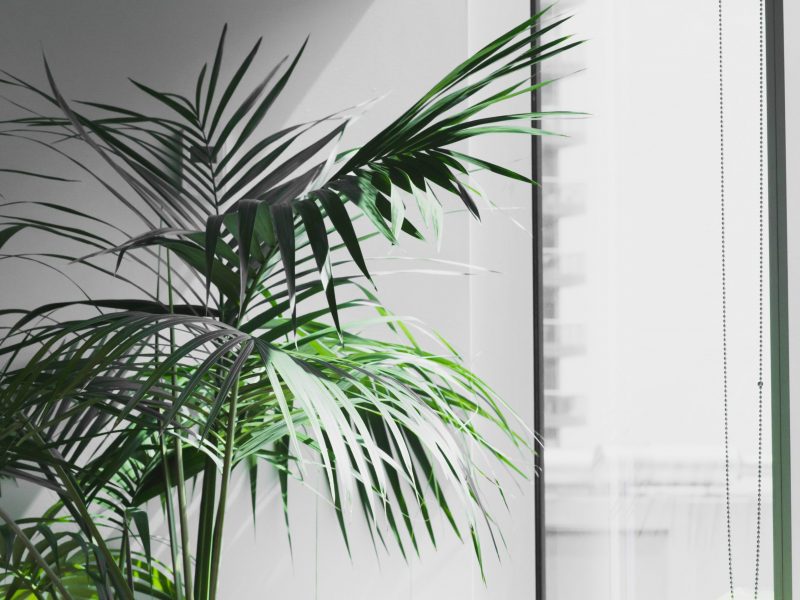
Perfect for beginner plant parents, the Kentia Palm is one we recommend to everyone as a stand-out minimalist houseplant but this doesn’t mean that they don’t come with issues every once in a while, such as yellow leaves, a drooping plant, leaf drop and brown leaves! There are quite a few reasons why Kentia Palms develop brown leaves or brown leaf tips, some more worrying than others.
In the post below, we will be going through each of the reasons, so it’s a good idea to inspect your Kentia Palm as we go through each of the factors so that you can determine what is causing the brown leaves on your Kentia Palm.
Too much fertiliser can cause brown leaf tips
When using fertiliser, you’ve probably seen the bottles recommend a certain dosage for your plant. However, each and every plant is different and size, plant type, maturity and environment can impact how much fertiliser your different houseplants need, so a one-fits-all approach doesn’t work with fertiliser. This can mean that you may have given your Kentia Palm too much fertiliser and this is what is causing the brown leaf tips.
We recommend popping your Kentia Palm in the shower and giving the soil a good wash through as this should flush out the excess fertiliser. Then just cut back on how much you fertilise your Palm by diluting the fertiliser more. Our plants have always liked the liquid fertiliser from Miracle Gro which is available on Amazon here.
You might also decide that you don’t want to fertilise or feed your Kentia Palm at all and that’s totally fine. You will see plenty of new healthy growth without using any fertiliser. In fact, we often go years without it. Instead, it can be a really good idea to refresh the soil that your Kentia Palm is growing in. This will ensure that there are still new nutrients available to your Palm without the need for risking brown leaves with fertiliser.
Low humidity levels can also cause brown leaf tips
Kentia Palms prefer slight above average humidity levels of they can start to dry out which shows itself as brown leaf tips and edges. There are a few really simple techniques to keep the humidity higher than normal for your Kentia Palm; a good one is to spray down the leaves with a mist bottle every few days, you can also build a pebbly tray by placing your plant over a bowl filled with water and pebbles. For a quick fix, you can put your Kentia Palm in the bathroom and leave the shower on hot for 5 minutes.
The best way, however, to consistently increase the humidity for your plant and avoid more brown leaves is by using a humidifier. They help to increase the water vapour in the air around your plants and will lead to a lot of happy and healthy plants which will keep the dry brown leaves away. You can also pick up a good humidity monitor to keep track of everything!
Brown leaves can indicate you are underwatering your Kentia Palm
Although it won’t die on you suddenly if you forget to water it every once in a while, consistent underwatering will start to have an impact on your Kentia Palm’s health and can often cause brown dry leaves. If you notice that your Kentia Palm’s leaves are turning try and crispy (usually starting from the tips inwards) it may be due to a consistent lack of water.
It’s a good idea to invest in a moisture meter if you haven’t already as this is the easiest and most reliable way to check the moisture levels in the soil. If your Kentia Palm does need more water your first instinct might be to give it an entire watering can full (or more) but this can actually be harmful to your Kentia Palm. Much like humans, plants get stressed by sudden changes in their environment (more on that below) and if their soil goes from bone dry to really soggy it can cause them to go into shock. This can cause more brown leaves, stagnant growth or can mean your plant loses some leaves. Instead, you want to reintroduce frequent watering for a few weeks and this should solve the problem.
Brown leaves on a Kentia Palm

Stress can also cause brown leaves
If you have ever moved house, you know just how stressful that can be and it turns out that plants find moving difficult too. There are a lot of changes that happen when you move your Kentia Palm, whether that is moving to a new home altogether or even just a different room. Temperature, light and humidity changes can all impact your Kentia Palm’s health and can cause brown leave to develop.
This is quite a temporary thing though so if you have recently moved your Palm, and the light, temperature and humidity levels are perfectly suitable for your palm then you just need to give it time to adjust to the new location. Trim off the brown leaves and be a little patient. If the problem continues longer than a few weeks, then this signals something else is wrong.
Brown leaves can be caused by low light
To properly photosynthesise your Kentia Palm needs a good level of sunlight and if it’s not receiving enough, this can cause brown leaves. A lack of sunlight is often paired with stunted growth or stems that look as though they are reaching for the light. This issue tends to be more common during winter when the sun is weaker and out for less of the day.
If you think that insufficient light levels are causing the brown leaves on your Kentia Palm, the best thing to do is start moving your plant a little closer to the window. You want to make sure that you don’t move it somewhere with too much direct light, especially in summer as this can burn the leaves.
You can also supplement the light your Kentia Palm is getting by using an LED grow light. These are great for plants struggling with a lack of sunlight as they allow you to control the additional light and will go a long way to preventing any more brown leaves from developing on your Kentia Palm. An LED light is also a great investment beyond supplementing light levels during winter to prevent more brown leaves and other issues as they are great for propagating plants too. They ensure that young cuttings or seedlings are growing in a bright environment to stimulate root growth.
Should I trim off the brown leaves on my Kentia Palm?
Now that the stress of diagnosing why your Kentia Palm has brown leaves is hopefully over and you are on your way to treating the problem and stopping more from occurring, you might be wondering what you should be doing with the brown leaves that are already there.
If it is only the leaf tips or edges that have turned brown, then we recommend keeping those leaves rather than cutting them off. Most of the leaf is still healthy and photosynthesising so your plant still needs it.
However, if the entire leaf has turned brown then it should be removed as it is unfortunately dead. Once the leaf (or even part of a leaf) has turned brown, there is no going back to the luscious green colour.
The reason that you want to remove the leaves is that you want your plant to focus on new growth. You don’t want your Kentia Palm to waste energy trying to keep those dying leaves alive. Trimming away the dead leaves allows your Kentia Palm to put all of its energy into new growth.
When removing the leaves, make sure to trim them off using sharp tools. Never rip or pull the leaves off by hand as this can damage the stems and other parts of the plant that might be otherwise healthy.
How do I stop my Kentia Palm from developing brown leaves?
The main thing you need to focus on with all plants to keep them thriving is adjusting the environment and care routine to suit them. All plant types need slightly different watering habits, can adapt to different light levels and some are more sensitive to dry air than others.
So to stop your Kentia Palm from developing more brown leaves you need to make sure you know what it needs and how to give it those requirements. Take a look through our Kentia Palm care guide to find out more about what your Palm needs to thrive.
Can the brown leaves on my Kentia Palm turn brown again?
Unfortunately, when a leaf turns brown this is irreversible. This is because the part of the leaf has died and dried out.
Those are the most common reasons why Kentia Palms develop brown leaves or brown leaf tips. We recommend not discounting any of the issues but going through each one and seeing if it matches what is happening with your plant. Using moisture, humidity and light monitors are great tools to make sure that the environment your Kentia Palm is in, is actually giving your plant what it needs.
You can learn more about caring for your plant in our Kentia Palm care guide.














